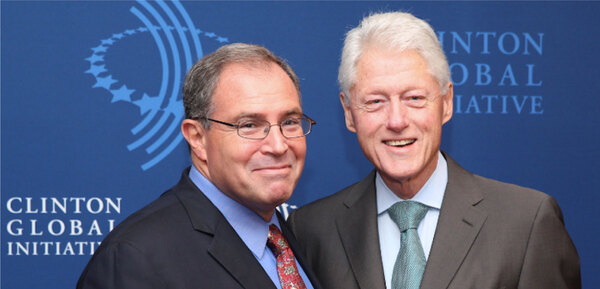作者:前世衛高級官員 德瑞克·亞克(Former senior WHO official Derek Yach)
發表日期:2024年4月6日
DOI:https://doi.org/10.1016/S0140-6736(24)00245-9
發型期刊單位:《柳葉刀/刺胳針》(The Lancet)

(左)前世衛高級官員德瑞克 亞克,(右)美國前總統比爾 柯林頓。/照片來源:BizNews, Alec Hogg。
李凱莉(Kelley Lee)及其同事描述了世界衛生組織 菸草控制框架公約(WHO FCTC)的艱難取得的進展。作為從FCTC的構思到採納的一員,我提供了一些見解,強調了這一公約如何未能適應科學和技術進步,注定將更多使用有毒菸草產品的人生命縮短,生活更不健康。
李凱莉及其同事承認結束吸煙的進展緩慢,但他們主張採取更多目前的FCTC行動,而不考慮減少菸草危害。盡管FCTC行動的持續將耗費逾4000億美元,他們必須知道這一數字是無法實現的。相反,我們應該問問可以做些什麼不同的事情。
減少菸草危害(Tobacco harm reduction)是FCTC對菸草控制的定義的一部分,但它卻強調禁令、禁止和規定,這些會削弱數百萬人對更安全的代用產品(如電子尼古丁傳遞裝置和尼古丁袋)的接觸。其中一些替代品已獲得美國食品和藥物管理局的銷售與行銷授權並得到各國政府的支持。至關重要的是,有超過1.2億人使用這些代用品,似乎與尼古丁替代療法相比改善了戒煙嘗試。
李凱莉及其同事將跨國菸草公司定性為純粹旨在擴大市場,但未考慮到廣泛談判的復雜性和微妙性;這導致除美國和印尼外的所有主要菸草生產商成為FCTC的簽署方。相反,我建議李凱莉及其同事考慮這些遺留公司如何隨著技術的演進而遠離可燃菸草向更安全的代用品發展。
此外,跨國菸草公司正被新的高度創新的菸草減害公司加入和推動。我們無需等待神奇的4000億美元來加速結束吸煙。在嚴格監管下,行業的力量可以確保成年吸煙者有機會使用更安全的產品作為戒煙途徑。
是的,轉型並提供更安全代用品的菸草公司會獲利,但這種利潤可能會帶來2025年至2060年間潛在減少1億死亡的可能性。
DY曾擔任世界衛生組織無煙倡議(Tobacco Free Initiative, WHO)的首任主任。他創立並領導了無煙世界基金會,並在菸草控制方面花費了35年時間。
李凱莉及其同事承認結束吸煙的進展緩慢,但他們主張採取更多目前的FCTC行動,而不考慮減少菸草危害。盡管FCTC行動的持續將耗費逾4000億美元,他們必須知道這一數字是無法實現的。相反,我們應該問問可以做些什麼不同的事情。
減少菸草危害(Tobacco harm reduction)是FCTC對菸草控制的定義的一部分,但它卻強調禁令、禁止和規定,這些會削弱數百萬人對更安全的代用產品(如電子尼古丁傳遞裝置和尼古丁袋)的接觸。其中一些替代品已獲得美國食品和藥物管理局的銷售與行銷授權並得到各國政府的支持。至關重要的是,有超過1.2億人使用這些代用品,似乎與尼古丁替代療法相比改善了戒煙嘗試。
李凱莉及其同事將跨國菸草公司定性為純粹旨在擴大市場,但未考慮到廣泛談判的復雜性和微妙性;這導致除美國和印尼外的所有主要菸草生產商成為FCTC的簽署方。相反,我建議李凱莉及其同事考慮這些遺留公司如何隨著技術的演進而遠離可燃菸草向更安全的代用品發展。
此外,跨國菸草公司正被新的高度創新的菸草減害公司加入和推動。我們無需等待神奇的4000億美元來加速結束吸煙。在嚴格監管下,行業的力量可以確保成年吸煙者有機會使用更安全的產品作為戒煙途徑。
是的,轉型並提供更安全代用品的菸草公司會獲利,但這種利潤可能會帶來2025年至2060年間潛在減少1億死亡的可能性。
DY曾擔任世界衛生組織無煙倡議(Tobacco Free Initiative, WHO)的首任主任。他創立並領導了無煙世界基金會,並在菸草控制方面花費了35年時間。
英文內文:
Kelly Li and colleagues describe the difficult progress made on the World Health Organization Framework Convention on Tobacco Control (WHO FCTC). As a member of the FCTC from its conception to its adoption, I provide insights that highlight how this treaty has failed to adapt to scientific and technological advances, dooming more people to live shorter and less healthy lives using toxic tobacco products.
Kelly Lee and colleagues acknowledge that progress toward ending smoking has been slow, but they advocate for more current FCTC actions without considering tobacco harm reduction. Although continued FCTC actions will cost more than $400 billion, they must know that this number is unattainable. Instead, we should ask what could be done differently.
Tobacco harm reduction is part of the FCTC’s definition of tobacco control, but it emphasizes bans, prohibitions and regulations that undermine millions of people’s access to safer alternatives such as electronic nicotine delivery devices and nicotine pouches. Some of these alternatives have received sales and marketing authorization from the U.S. Food and Drug Administration and support from various governments. Crucially, these substitutes, used by more than 120 million people, appear to improve quit attempts compared with nicotine replacement therapy.
Kelly Lee and her colleagues characterized multinational tobacco companies as purely aiming to expand their markets, but failed to take into account the complexities and subtleties of the extensive negotiations; this resulted in all major tobacco producers except the United States and Indonesia becoming signatories to the FCTC. Instead, I suggest Kelly Lee and colleagues consider how these legacy companies may evolve away from combustible tobacco and toward safer alternatives as technology evolves.
In addition, multinational tobacco companies are being joined and promoted by new, highly innovative tobacco harm reduction companies. We don’t need to wait for the magic $400 billion to accelerate the end of smoking. Under strict regulation, the power of industry can ensure that adult smokers have access to safer products as a route to quitting.
Yes, tobacco companies that pivot and offer safer alternatives will profit, but that profit could come with the potential to prevent 100 million deaths between 2025 and 2060.
DY served as the first director of the World Health Organization’s Smoke-Free Initiative. He founded and led the Foundation for a Smoke-Free World and spent 35 years working on tobacco control.
延伸閱讀:
維基百科:https://en.wikipedia.org/wiki/Derek_Yach
世衛前官員批WHO反煙20年失敗:全球逾10億人吸煙
https://www.peopo.org/news/545924
菸害防制被政治綁架 Derek Yach:應由科學證據決策
https://reurl.cc/prQLKa
推動菸害防制與國際接軌-電子菸/加熱菸/尼古丁袋合法抽稅納管
https://www.zeczec.com/projects/tthra

